Financial Accounting Report: Analysis of Financial Principles
VerifiedAdded on 2021/02/19
|24
|5821
|433
Report
AI Summary
This report delves into the core principles of financial accounting, examining its purpose and legal requirements, particularly within the context of a small accounting company named Brook City. It contrasts financial and management accounting, highlighting their differences in legal requirements, focus, and adherence to GAAP. The report identifies and differentiates between internal and external stakeholders, emphasizing the importance of financial information for their decision-making processes. Furthermore, the assignment provides practical examples, including double-entry bookkeeping with ledgers for various clients, demonstrating the application of accounting principles in real-world scenarios. The report covers the creation of essential financial statements such as balance sheets and trial balances, as per accounting rules and standards.
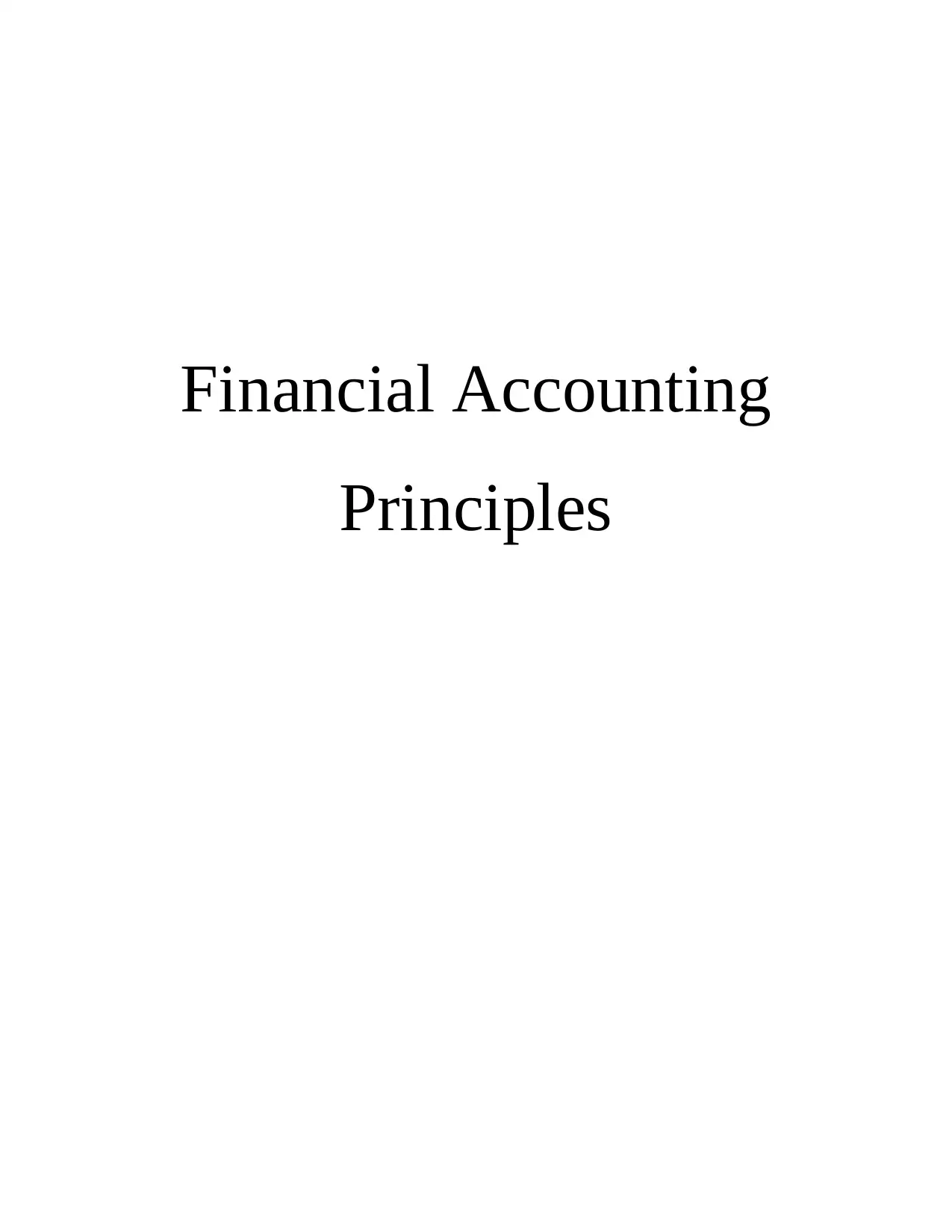
Financial Accounting
Principles
Principles
Paraphrase This Document
Need a fresh take? Get an instant paraphrase of this document with our AI Paraphraser
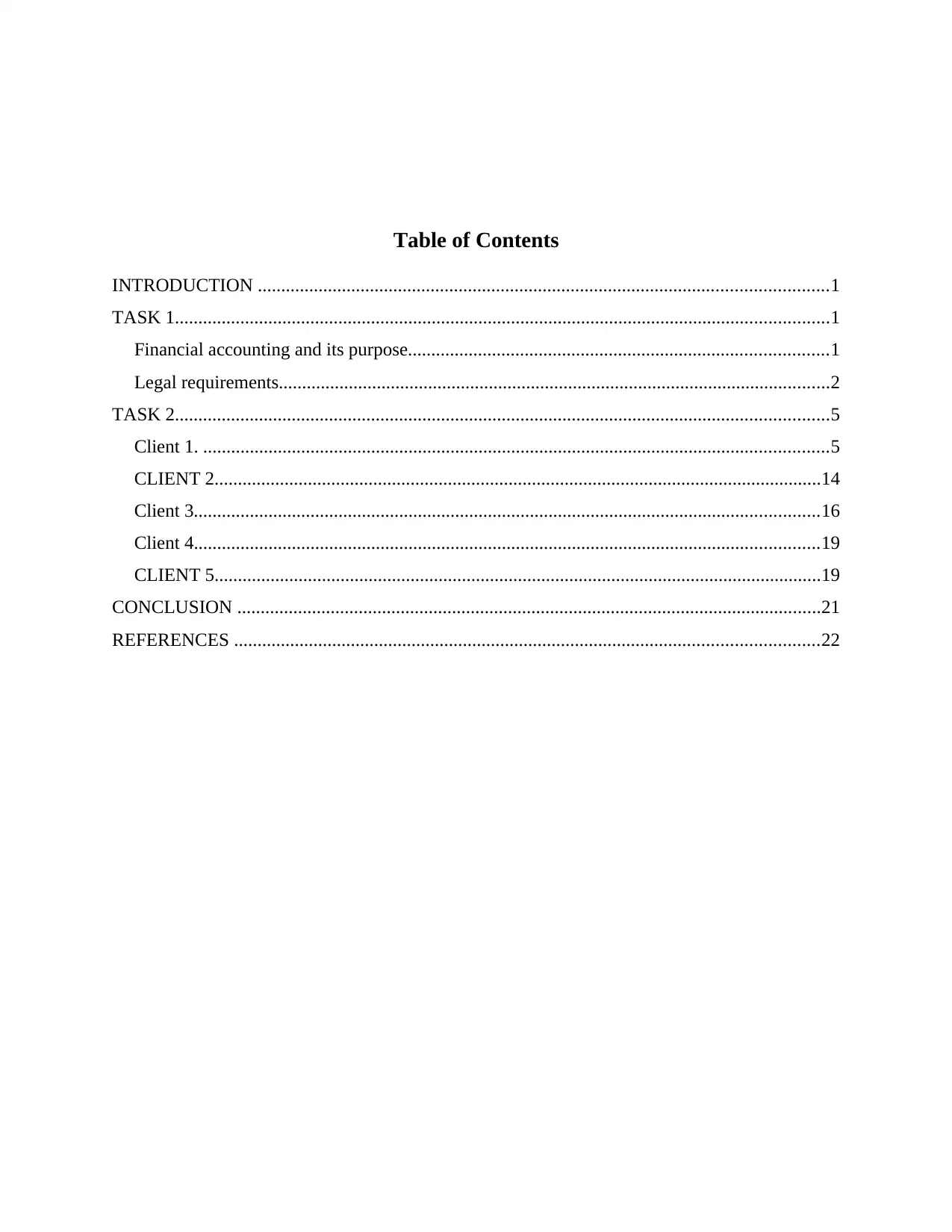
Table of Contents
INTRODUCTION ..........................................................................................................................1
TASK 1............................................................................................................................................1
Financial accounting and its purpose..........................................................................................1
Legal requirements......................................................................................................................2
TASK 2............................................................................................................................................5
Client 1. ......................................................................................................................................5
CLIENT 2..................................................................................................................................14
Client 3......................................................................................................................................16
Client 4......................................................................................................................................19
CLIENT 5..................................................................................................................................19
CONCLUSION .............................................................................................................................21
REFERENCES .............................................................................................................................22
INTRODUCTION ..........................................................................................................................1
TASK 1............................................................................................................................................1
Financial accounting and its purpose..........................................................................................1
Legal requirements......................................................................................................................2
TASK 2............................................................................................................................................5
Client 1. ......................................................................................................................................5
CLIENT 2..................................................................................................................................14
Client 3......................................................................................................................................16
Client 4......................................................................................................................................19
CLIENT 5..................................................................................................................................19
CONCLUSION .............................................................................................................................21
REFERENCES .............................................................................................................................22
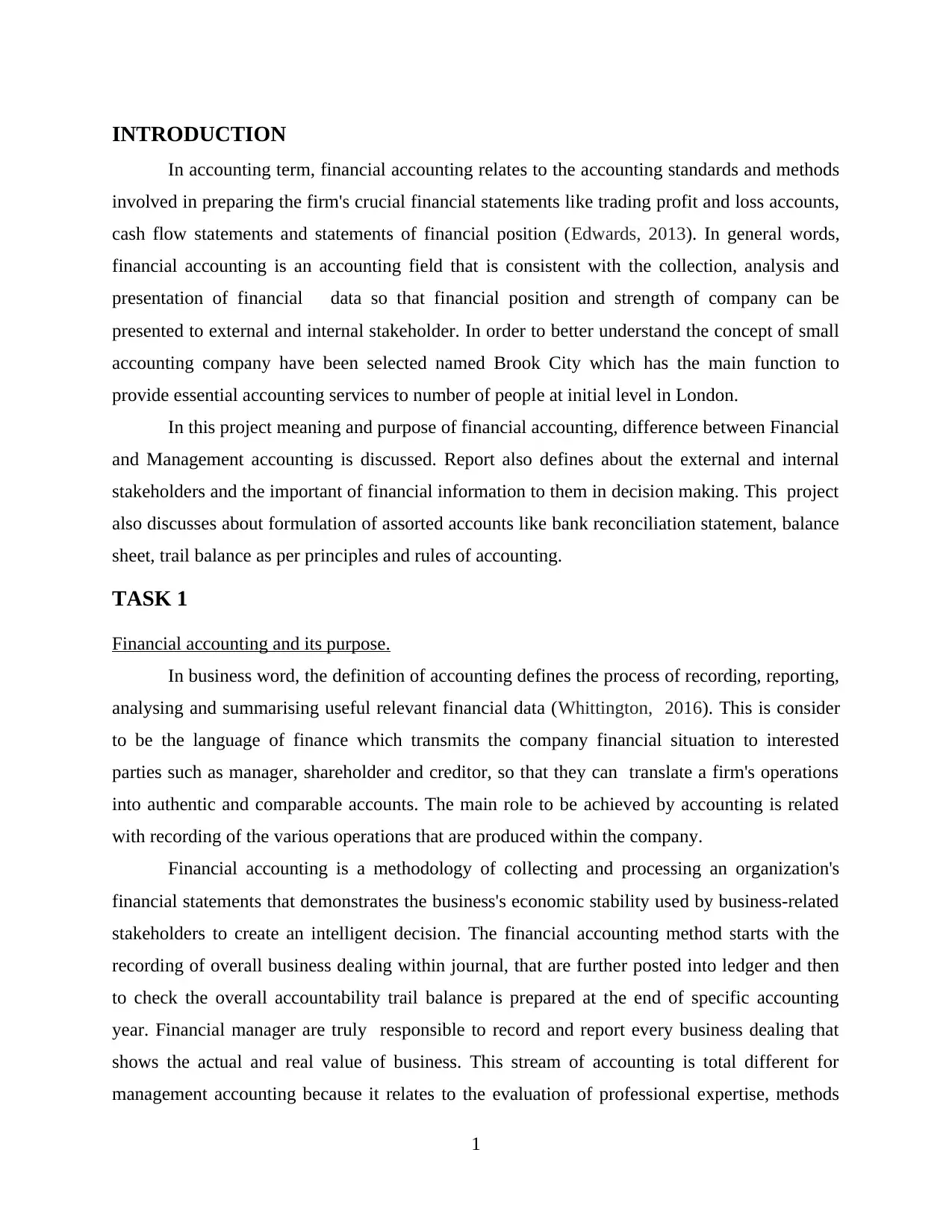
INTRODUCTION
In accounting term, financial accounting relates to the accounting standards and methods
involved in preparing the firm's crucial financial statements like trading profit and loss accounts,
cash flow statements and statements of financial position (Edwards, 2013). In general words,
financial accounting is an accounting field that is consistent with the collection, analysis and
presentation of financial data so that financial position and strength of company can be
presented to external and internal stakeholder. In order to better understand the concept of small
accounting company have been selected named Brook City which has the main function to
provide essential accounting services to number of people at initial level in London.
In this project meaning and purpose of financial accounting, difference between Financial
and Management accounting is discussed. Report also defines about the external and internal
stakeholders and the important of financial information to them in decision making. This project
also discusses about formulation of assorted accounts like bank reconciliation statement, balance
sheet, trail balance as per principles and rules of accounting.
TASK 1
Financial accounting and its purpose.
In business word, the definition of accounting defines the process of recording, reporting,
analysing and summarising useful relevant financial data (Whittington, 2016). This is consider
to be the language of finance which transmits the company financial situation to interested
parties such as manager, shareholder and creditor, so that they can translate a firm's operations
into authentic and comparable accounts. The main role to be achieved by accounting is related
with recording of the various operations that are produced within the company.
Financial accounting is a methodology of collecting and processing an organization's
financial statements that demonstrates the business's economic stability used by business-related
stakeholders to create an intelligent decision. The financial accounting method starts with the
recording of overall business dealing within journal, that are further posted into ledger and then
to check the overall accountability trail balance is prepared at the end of specific accounting
year. Financial manager are truly responsible to record and report every business dealing that
shows the actual and real value of business. This stream of accounting is total different for
management accounting because it relates to the evaluation of professional expertise, methods
1
In accounting term, financial accounting relates to the accounting standards and methods
involved in preparing the firm's crucial financial statements like trading profit and loss accounts,
cash flow statements and statements of financial position (Edwards, 2013). In general words,
financial accounting is an accounting field that is consistent with the collection, analysis and
presentation of financial data so that financial position and strength of company can be
presented to external and internal stakeholder. In order to better understand the concept of small
accounting company have been selected named Brook City which has the main function to
provide essential accounting services to number of people at initial level in London.
In this project meaning and purpose of financial accounting, difference between Financial
and Management accounting is discussed. Report also defines about the external and internal
stakeholders and the important of financial information to them in decision making. This project
also discusses about formulation of assorted accounts like bank reconciliation statement, balance
sheet, trail balance as per principles and rules of accounting.
TASK 1
Financial accounting and its purpose.
In business word, the definition of accounting defines the process of recording, reporting,
analysing and summarising useful relevant financial data (Whittington, 2016). This is consider
to be the language of finance which transmits the company financial situation to interested
parties such as manager, shareholder and creditor, so that they can translate a firm's operations
into authentic and comparable accounts. The main role to be achieved by accounting is related
with recording of the various operations that are produced within the company.
Financial accounting is a methodology of collecting and processing an organization's
financial statements that demonstrates the business's economic stability used by business-related
stakeholders to create an intelligent decision. The financial accounting method starts with the
recording of overall business dealing within journal, that are further posted into ledger and then
to check the overall accountability trail balance is prepared at the end of specific accounting
year. Financial manager are truly responsible to record and report every business dealing that
shows the actual and real value of business. This stream of accounting is total different for
management accounting because it relates to the evaluation of professional expertise, methods
1
⊘ This is a preview!⊘
Do you want full access?
Subscribe today to unlock all pages.

Trusted by 1+ million students worldwide
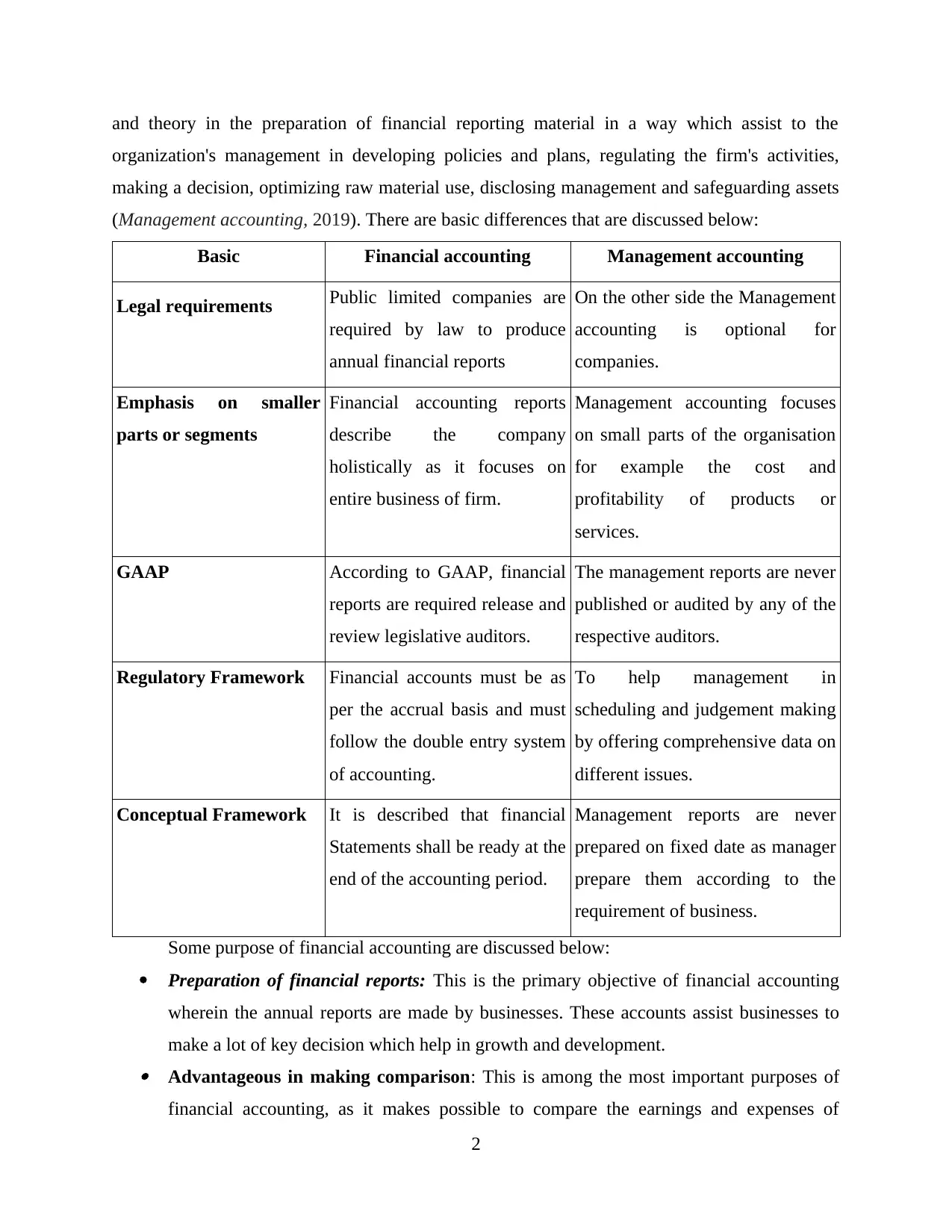
and theory in the preparation of financial reporting material in a way which assist to the
organization's management in developing policies and plans, regulating the firm's activities,
making a decision, optimizing raw material use, disclosing management and safeguarding assets
(Management accounting, 2019). There are basic differences that are discussed below:
Basic Financial accounting Management accounting
Legal requirements Public limited companies are
required by law to produce
annual financial reports
On the other side the Management
accounting is optional for
companies.
Emphasis on smaller
parts or segments
Financial accounting reports
describe the company
holistically as it focuses on
entire business of firm.
Management accounting focuses
on small parts of the organisation
for example the cost and
profitability of products or
services.
GAAP According to GAAP, financial
reports are required release and
review legislative auditors.
The management reports are never
published or audited by any of the
respective auditors.
Regulatory Framework Financial accounts must be as
per the accrual basis and must
follow the double entry system
of accounting.
To help management in
scheduling and judgement making
by offering comprehensive data on
different issues.
Conceptual Framework It is described that financial
Statements shall be ready at the
end of the accounting period.
Management reports are never
prepared on fixed date as manager
prepare them according to the
requirement of business.
Some purpose of financial accounting are discussed below:
Preparation of financial reports: This is the primary objective of financial accounting
wherein the annual reports are made by businesses. These accounts assist businesses to
make a lot of key decision which help in growth and development. Advantageous in making comparison: This is among the most important purposes of
financial accounting, as it makes possible to compare the earnings and expenses of
2
organization's management in developing policies and plans, regulating the firm's activities,
making a decision, optimizing raw material use, disclosing management and safeguarding assets
(Management accounting, 2019). There are basic differences that are discussed below:
Basic Financial accounting Management accounting
Legal requirements Public limited companies are
required by law to produce
annual financial reports
On the other side the Management
accounting is optional for
companies.
Emphasis on smaller
parts or segments
Financial accounting reports
describe the company
holistically as it focuses on
entire business of firm.
Management accounting focuses
on small parts of the organisation
for example the cost and
profitability of products or
services.
GAAP According to GAAP, financial
reports are required release and
review legislative auditors.
The management reports are never
published or audited by any of the
respective auditors.
Regulatory Framework Financial accounts must be as
per the accrual basis and must
follow the double entry system
of accounting.
To help management in
scheduling and judgement making
by offering comprehensive data on
different issues.
Conceptual Framework It is described that financial
Statements shall be ready at the
end of the accounting period.
Management reports are never
prepared on fixed date as manager
prepare them according to the
requirement of business.
Some purpose of financial accounting are discussed below:
Preparation of financial reports: This is the primary objective of financial accounting
wherein the annual reports are made by businesses. These accounts assist businesses to
make a lot of key decision which help in growth and development. Advantageous in making comparison: This is among the most important purposes of
financial accounting, as it makes possible to compare the earnings and expenses of
2
Paraphrase This Document
Need a fresh take? Get an instant paraphrase of this document with our AI Paraphraser
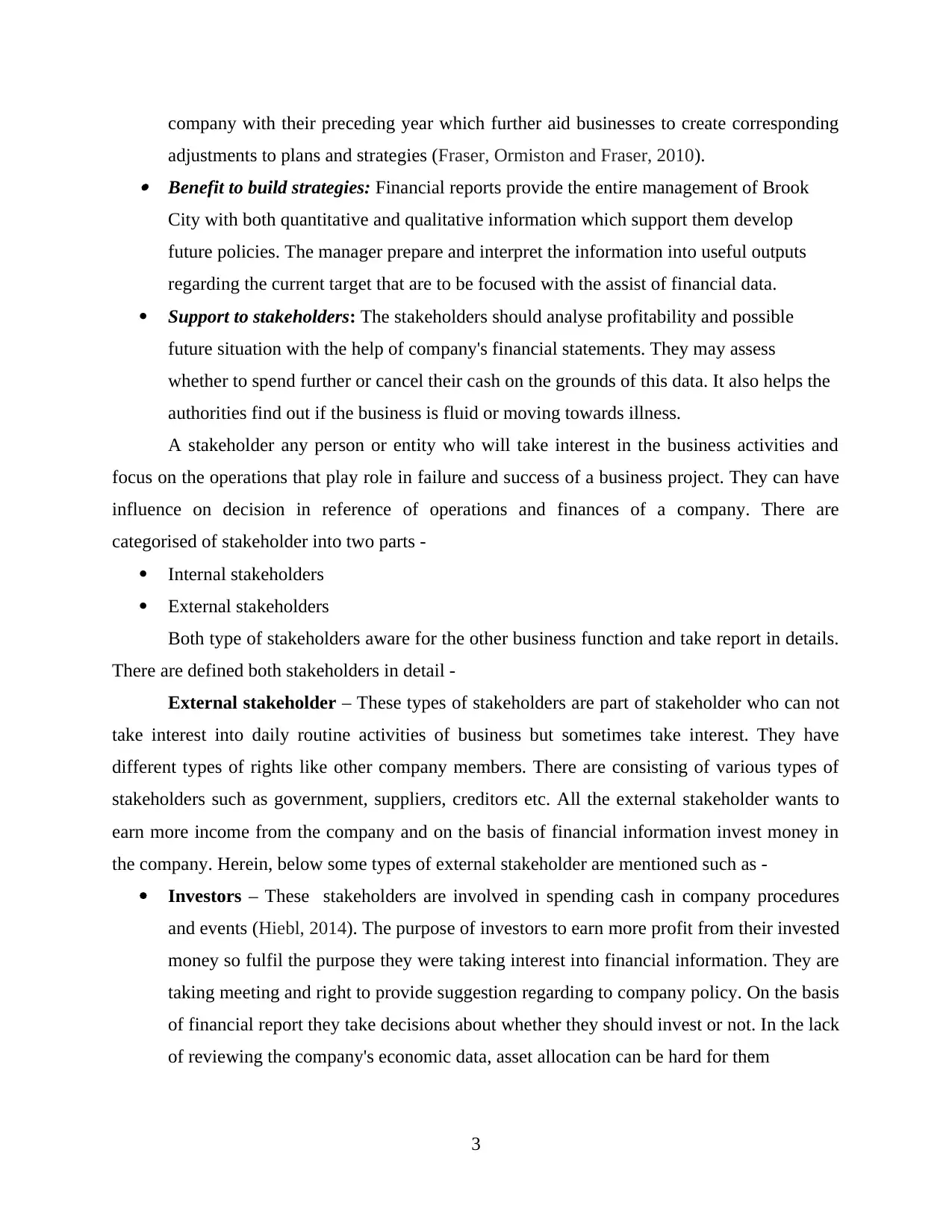
company with their preceding year which further aid businesses to create corresponding
adjustments to plans and strategies (Fraser, Ormiston and Fraser, 2010). Benefit to build strategies: Financial reports provide the entire management of Brook
City with both quantitative and qualitative information which support them develop
future policies. The manager prepare and interpret the information into useful outputs
regarding the current target that are to be focused with the assist of financial data.
Support to stakeholders: The stakeholders should analyse profitability and possible
future situation with the help of company's financial statements. They may assess
whether to spend further or cancel their cash on the grounds of this data. It also helps the
authorities find out if the business is fluid or moving towards illness.
A stakeholder any person or entity who will take interest in the business activities and
focus on the operations that play role in failure and success of a business project. They can have
influence on decision in reference of operations and finances of a company. There are
categorised of stakeholder into two parts -
Internal stakeholders
External stakeholders
Both type of stakeholders aware for the other business function and take report in details.
There are defined both stakeholders in detail -
External stakeholder – These types of stakeholders are part of stakeholder who can not
take interest into daily routine activities of business but sometimes take interest. They have
different types of rights like other company members. There are consisting of various types of
stakeholders such as government, suppliers, creditors etc. All the external stakeholder wants to
earn more income from the company and on the basis of financial information invest money in
the company. Herein, below some types of external stakeholder are mentioned such as -
Investors – These stakeholders are involved in spending cash in company procedures
and events (Hiebl, 2014). The purpose of investors to earn more profit from their invested
money so fulfil the purpose they were taking interest into financial information. They are
taking meeting and right to provide suggestion regarding to company policy. On the basis
of financial report they take decisions about whether they should invest or not. In the lack
of reviewing the company's economic data, asset allocation can be hard for them
3
adjustments to plans and strategies (Fraser, Ormiston and Fraser, 2010). Benefit to build strategies: Financial reports provide the entire management of Brook
City with both quantitative and qualitative information which support them develop
future policies. The manager prepare and interpret the information into useful outputs
regarding the current target that are to be focused with the assist of financial data.
Support to stakeholders: The stakeholders should analyse profitability and possible
future situation with the help of company's financial statements. They may assess
whether to spend further or cancel their cash on the grounds of this data. It also helps the
authorities find out if the business is fluid or moving towards illness.
A stakeholder any person or entity who will take interest in the business activities and
focus on the operations that play role in failure and success of a business project. They can have
influence on decision in reference of operations and finances of a company. There are
categorised of stakeholder into two parts -
Internal stakeholders
External stakeholders
Both type of stakeholders aware for the other business function and take report in details.
There are defined both stakeholders in detail -
External stakeholder – These types of stakeholders are part of stakeholder who can not
take interest into daily routine activities of business but sometimes take interest. They have
different types of rights like other company members. There are consisting of various types of
stakeholders such as government, suppliers, creditors etc. All the external stakeholder wants to
earn more income from the company and on the basis of financial information invest money in
the company. Herein, below some types of external stakeholder are mentioned such as -
Investors – These stakeholders are involved in spending cash in company procedures
and events (Hiebl, 2014). The purpose of investors to earn more profit from their invested
money so fulfil the purpose they were taking interest into financial information. They are
taking meeting and right to provide suggestion regarding to company policy. On the basis
of financial report they take decisions about whether they should invest or not. In the lack
of reviewing the company's economic data, asset allocation can be hard for them
3
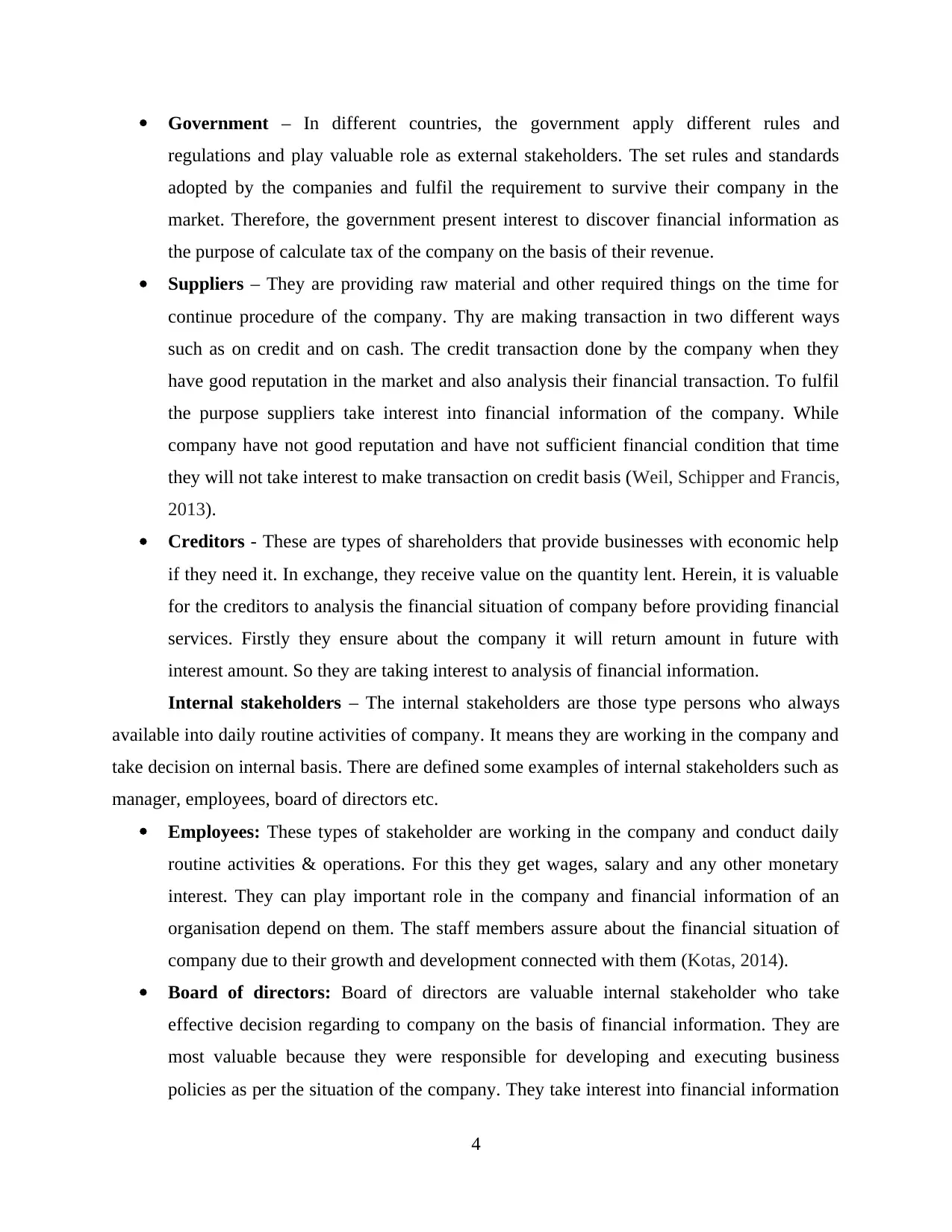
Government – In different countries, the government apply different rules and
regulations and play valuable role as external stakeholders. The set rules and standards
adopted by the companies and fulfil the requirement to survive their company in the
market. Therefore, the government present interest to discover financial information as
the purpose of calculate tax of the company on the basis of their revenue.
Suppliers – They are providing raw material and other required things on the time for
continue procedure of the company. Thy are making transaction in two different ways
such as on credit and on cash. The credit transaction done by the company when they
have good reputation in the market and also analysis their financial transaction. To fulfil
the purpose suppliers take interest into financial information of the company. While
company have not good reputation and have not sufficient financial condition that time
they will not take interest to make transaction on credit basis (Weil, Schipper and Francis,
2013).
Creditors - These are types of shareholders that provide businesses with economic help
if they need it. In exchange, they receive value on the quantity lent. Herein, it is valuable
for the creditors to analysis the financial situation of company before providing financial
services. Firstly they ensure about the company it will return amount in future with
interest amount. So they are taking interest to analysis of financial information.
Internal stakeholders – The internal stakeholders are those type persons who always
available into daily routine activities of company. It means they are working in the company and
take decision on internal basis. There are defined some examples of internal stakeholders such as
manager, employees, board of directors etc.
Employees: These types of stakeholder are working in the company and conduct daily
routine activities & operations. For this they get wages, salary and any other monetary
interest. They can play important role in the company and financial information of an
organisation depend on them. The staff members assure about the financial situation of
company due to their growth and development connected with them (Kotas, 2014).
Board of directors: Board of directors are valuable internal stakeholder who take
effective decision regarding to company on the basis of financial information. They are
most valuable because they were responsible for developing and executing business
policies as per the situation of the company. They take interest into financial information
4
regulations and play valuable role as external stakeholders. The set rules and standards
adopted by the companies and fulfil the requirement to survive their company in the
market. Therefore, the government present interest to discover financial information as
the purpose of calculate tax of the company on the basis of their revenue.
Suppliers – They are providing raw material and other required things on the time for
continue procedure of the company. Thy are making transaction in two different ways
such as on credit and on cash. The credit transaction done by the company when they
have good reputation in the market and also analysis their financial transaction. To fulfil
the purpose suppliers take interest into financial information of the company. While
company have not good reputation and have not sufficient financial condition that time
they will not take interest to make transaction on credit basis (Weil, Schipper and Francis,
2013).
Creditors - These are types of shareholders that provide businesses with economic help
if they need it. In exchange, they receive value on the quantity lent. Herein, it is valuable
for the creditors to analysis the financial situation of company before providing financial
services. Firstly they ensure about the company it will return amount in future with
interest amount. So they are taking interest to analysis of financial information.
Internal stakeholders – The internal stakeholders are those type persons who always
available into daily routine activities of company. It means they are working in the company and
take decision on internal basis. There are defined some examples of internal stakeholders such as
manager, employees, board of directors etc.
Employees: These types of stakeholder are working in the company and conduct daily
routine activities & operations. For this they get wages, salary and any other monetary
interest. They can play important role in the company and financial information of an
organisation depend on them. The staff members assure about the financial situation of
company due to their growth and development connected with them (Kotas, 2014).
Board of directors: Board of directors are valuable internal stakeholder who take
effective decision regarding to company on the basis of financial information. They are
most valuable because they were responsible for developing and executing business
policies as per the situation of the company. They take interest into financial information
4
⊘ This is a preview!⊘
Do you want full access?
Subscribe today to unlock all pages.

Trusted by 1+ million students worldwide
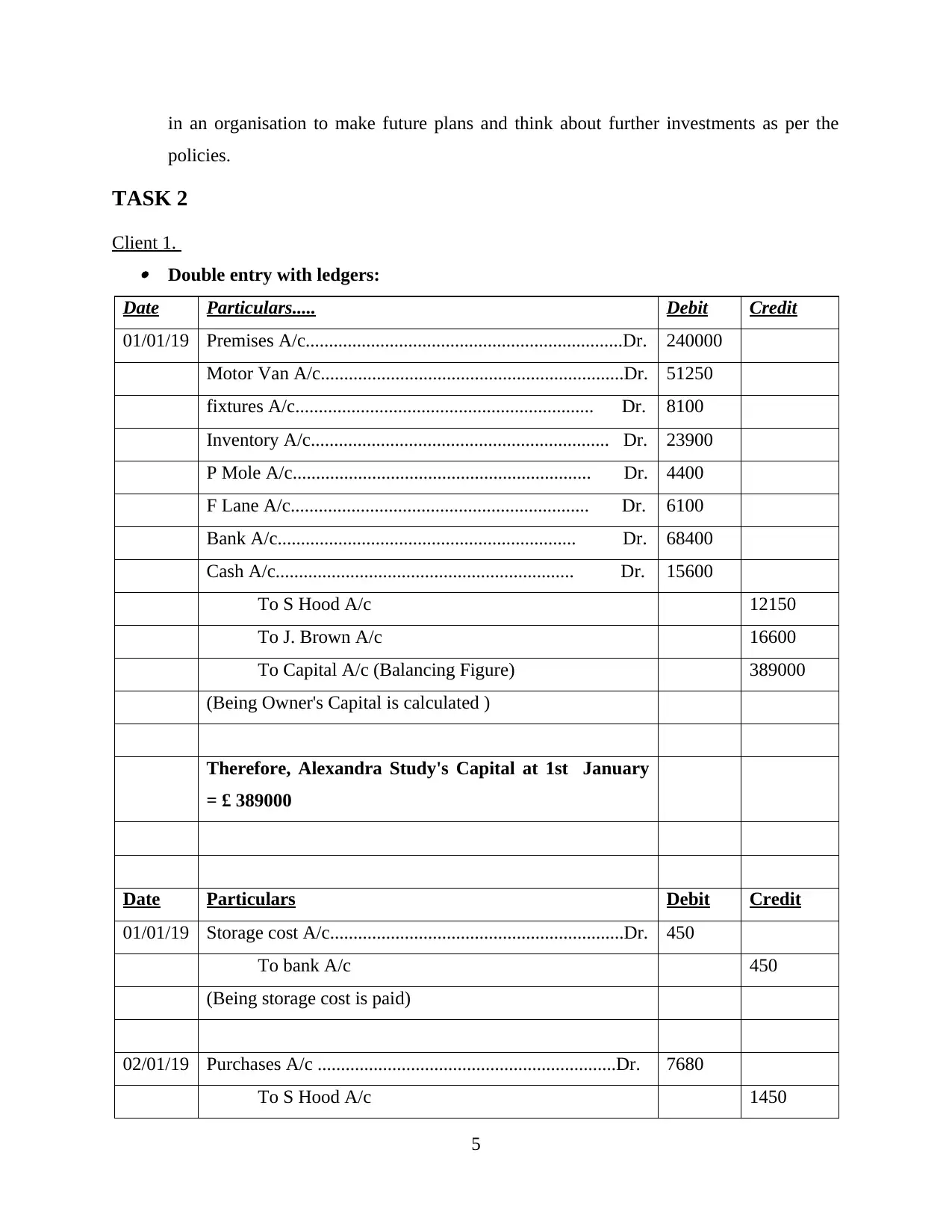
in an organisation to make future plans and think about further investments as per the
policies.
TASK 2
Client 1. Double entry with ledgers:
Date Particulars..... Debit Credit
01/01/19 Premises A/c....................................................................Dr. 240000
Motor Van A/c.................................................................Dr. 51250
fixtures A/c................................................................ Dr. 8100
Inventory A/c................................................................ Dr. 23900
P Mole A/c................................................................ Dr. 4400
F Lane A/c................................................................ Dr. 6100
Bank A/c................................................................ Dr. 68400
Cash A/c................................................................ Dr. 15600
To S Hood A/c 12150
To J. Brown A/c 16600
To Capital A/c (Balancing Figure) 389000
(Being Owner's Capital is calculated )
Therefore, Alexandra Study's Capital at 1st January
= £ 389000
Date Particulars Debit Credit
01/01/19 Storage cost A/c...............................................................Dr. 450
To bank A/c 450
(Being storage cost is paid)
02/01/19 Purchases A/c ................................................................Dr. 7680
To S Hood A/c 1450
5
policies.
TASK 2
Client 1. Double entry with ledgers:
Date Particulars..... Debit Credit
01/01/19 Premises A/c....................................................................Dr. 240000
Motor Van A/c.................................................................Dr. 51250
fixtures A/c................................................................ Dr. 8100
Inventory A/c................................................................ Dr. 23900
P Mole A/c................................................................ Dr. 4400
F Lane A/c................................................................ Dr. 6100
Bank A/c................................................................ Dr. 68400
Cash A/c................................................................ Dr. 15600
To S Hood A/c 12150
To J. Brown A/c 16600
To Capital A/c (Balancing Figure) 389000
(Being Owner's Capital is calculated )
Therefore, Alexandra Study's Capital at 1st January
= £ 389000
Date Particulars Debit Credit
01/01/19 Storage cost A/c...............................................................Dr. 450
To bank A/c 450
(Being storage cost is paid)
02/01/19 Purchases A/c ................................................................Dr. 7680
To S Hood A/c 1450
5
Paraphrase This Document
Need a fresh take? Get an instant paraphrase of this document with our AI Paraphraser
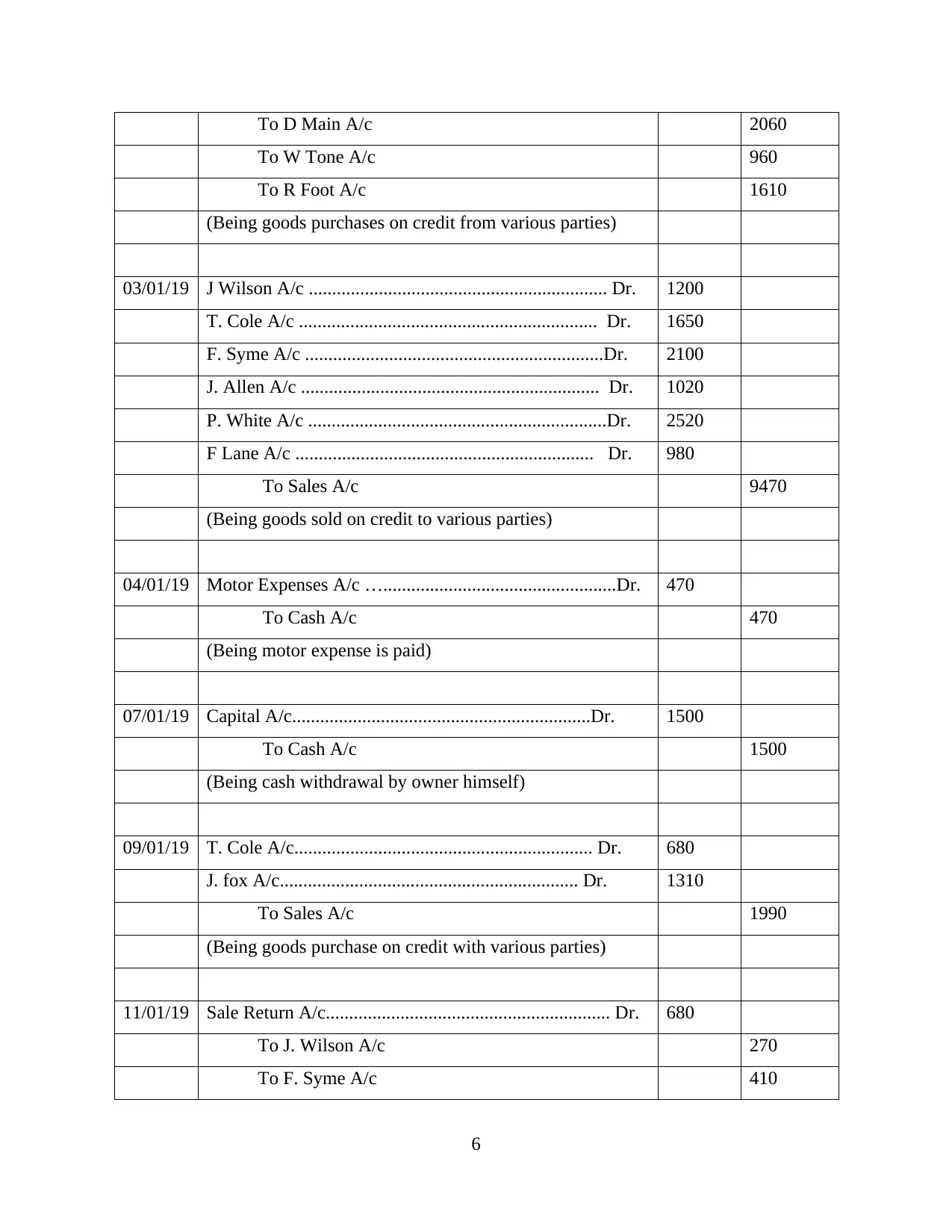
To D Main A/c 2060
To W Tone A/c 960
To R Foot A/c 1610
(Being goods purchases on credit from various parties)
03/01/19 J Wilson A/c ................................................................ Dr. 1200
T. Cole A/c ................................................................ Dr. 1650
F. Syme A/c ................................................................Dr. 2100
J. Allen A/c ................................................................ Dr. 1020
P. White A/c ................................................................Dr. 2520
F Lane A/c ................................................................ Dr. 980
To Sales A/c 9470
(Being goods sold on credit to various parties)
04/01/19 Motor Expenses A/c …..................................................Dr. 470
To Cash A/c 470
(Being motor expense is paid)
07/01/19 Capital A/c................................................................Dr. 1500
To Cash A/c 1500
(Being cash withdrawal by owner himself)
09/01/19 T. Cole A/c................................................................ Dr. 680
J. fox A/c................................................................ Dr. 1310
To Sales A/c 1990
(Being goods purchase on credit with various parties)
11/01/19 Sale Return A/c............................................................. Dr. 680
To J. Wilson A/c 270
To F. Syme A/c 410
6
To W Tone A/c 960
To R Foot A/c 1610
(Being goods purchases on credit from various parties)
03/01/19 J Wilson A/c ................................................................ Dr. 1200
T. Cole A/c ................................................................ Dr. 1650
F. Syme A/c ................................................................Dr. 2100
J. Allen A/c ................................................................ Dr. 1020
P. White A/c ................................................................Dr. 2520
F Lane A/c ................................................................ Dr. 980
To Sales A/c 9470
(Being goods sold on credit to various parties)
04/01/19 Motor Expenses A/c …..................................................Dr. 470
To Cash A/c 470
(Being motor expense is paid)
07/01/19 Capital A/c................................................................Dr. 1500
To Cash A/c 1500
(Being cash withdrawal by owner himself)
09/01/19 T. Cole A/c................................................................ Dr. 680
J. fox A/c................................................................ Dr. 1310
To Sales A/c 1990
(Being goods purchase on credit with various parties)
11/01/19 Sale Return A/c............................................................. Dr. 680
To J. Wilson A/c 270
To F. Syme A/c 410
6
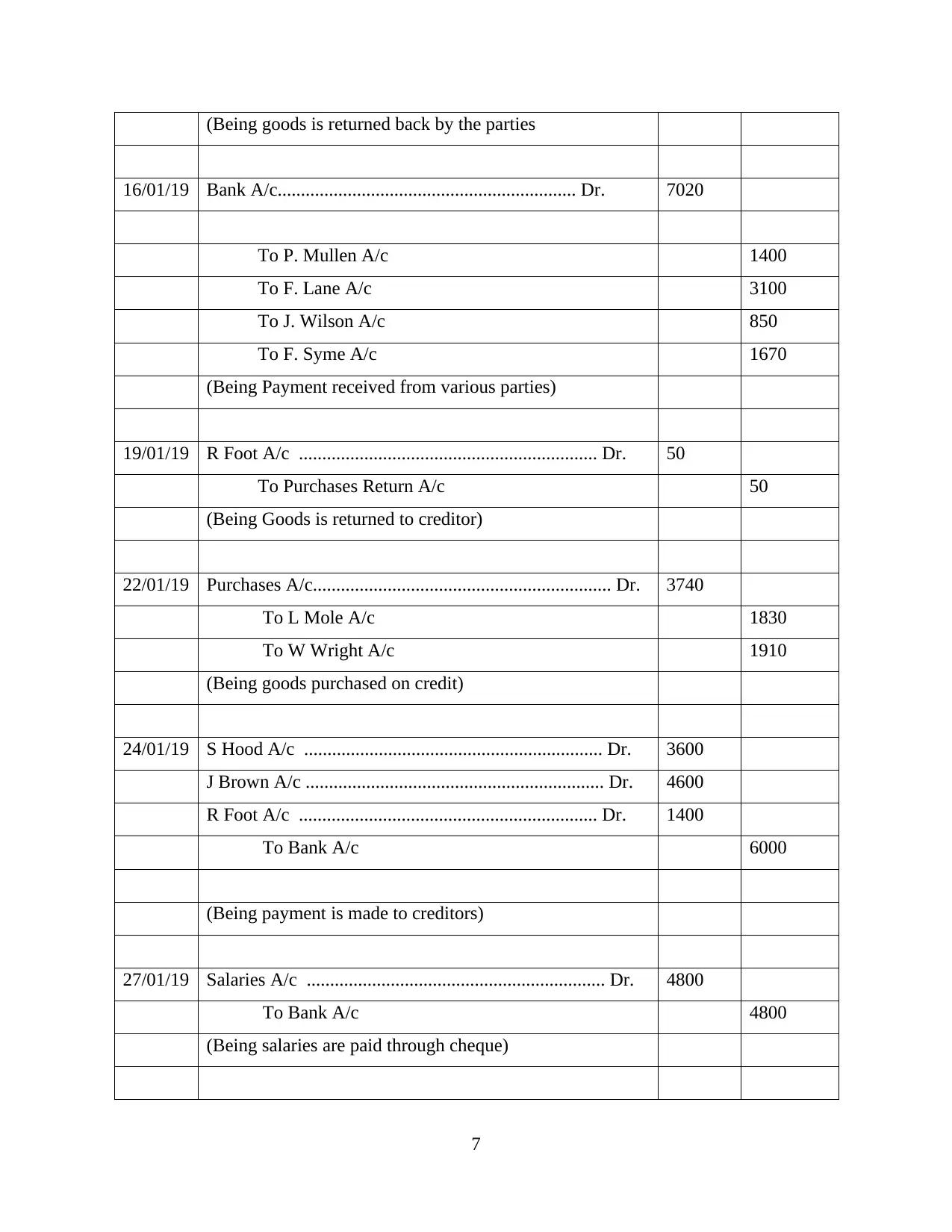
(Being goods is returned back by the parties
16/01/19 Bank A/c................................................................ Dr. 7020
To P. Mullen A/c 1400
To F. Lane A/c 3100
To J. Wilson A/c 850
To F. Syme A/c 1670
(Being Payment received from various parties)
19/01/19 R Foot A/c ................................................................ Dr. 50
To Purchases Return A/c 50
(Being Goods is returned to creditor)
22/01/19 Purchases A/c................................................................ Dr. 3740
To L Mole A/c 1830
To W Wright A/c 1910
(Being goods purchased on credit)
24/01/19 S Hood A/c ................................................................ Dr. 3600
J Brown A/c ................................................................ Dr. 4600
R Foot A/c ................................................................ Dr. 1400
To Bank A/c 6000
(Being payment is made to creditors)
27/01/19 Salaries A/c ................................................................ Dr. 4800
To Bank A/c 4800
(Being salaries are paid through cheque)
7
16/01/19 Bank A/c................................................................ Dr. 7020
To P. Mullen A/c 1400
To F. Lane A/c 3100
To J. Wilson A/c 850
To F. Syme A/c 1670
(Being Payment received from various parties)
19/01/19 R Foot A/c ................................................................ Dr. 50
To Purchases Return A/c 50
(Being Goods is returned to creditor)
22/01/19 Purchases A/c................................................................ Dr. 3740
To L Mole A/c 1830
To W Wright A/c 1910
(Being goods purchased on credit)
24/01/19 S Hood A/c ................................................................ Dr. 3600
J Brown A/c ................................................................ Dr. 4600
R Foot A/c ................................................................ Dr. 1400
To Bank A/c 6000
(Being payment is made to creditors)
27/01/19 Salaries A/c ................................................................ Dr. 4800
To Bank A/c 4800
(Being salaries are paid through cheque)
7
⊘ This is a preview!⊘
Do you want full access?
Subscribe today to unlock all pages.

Trusted by 1+ million students worldwide
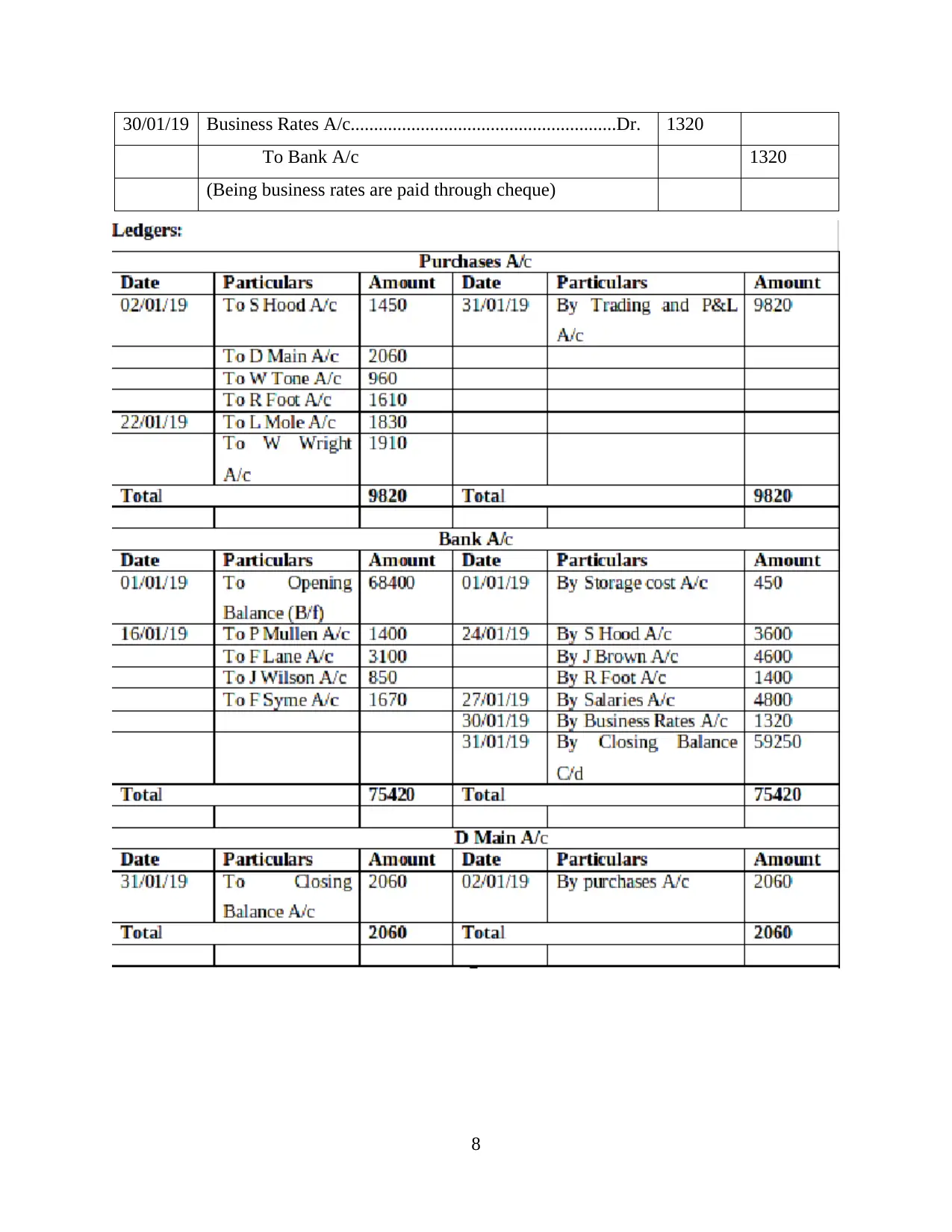
30/01/19 Business Rates A/c.........................................................Dr. 1320
To Bank A/c 1320
(Being business rates are paid through cheque)
8
To Bank A/c 1320
(Being business rates are paid through cheque)
8
Paraphrase This Document
Need a fresh take? Get an instant paraphrase of this document with our AI Paraphraser
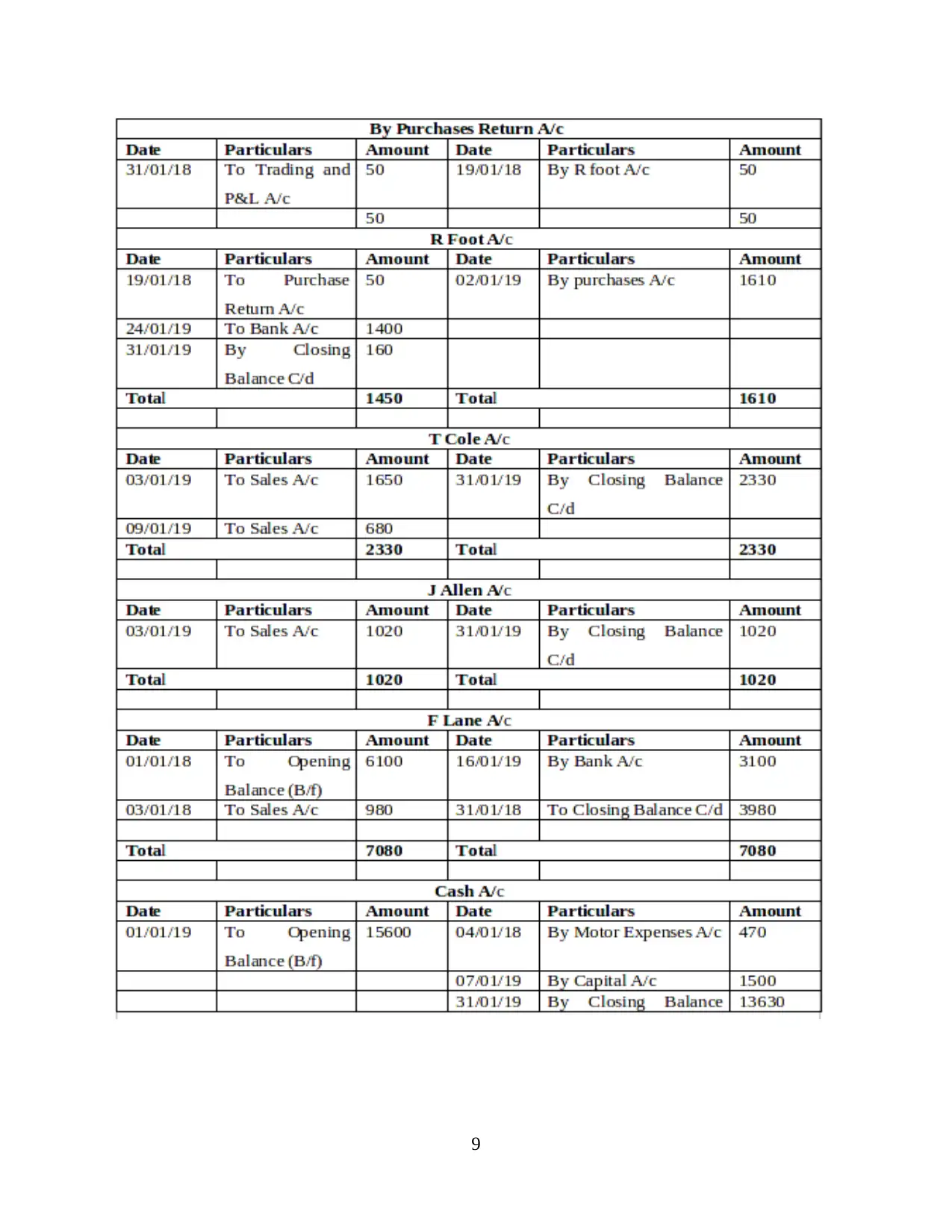
9
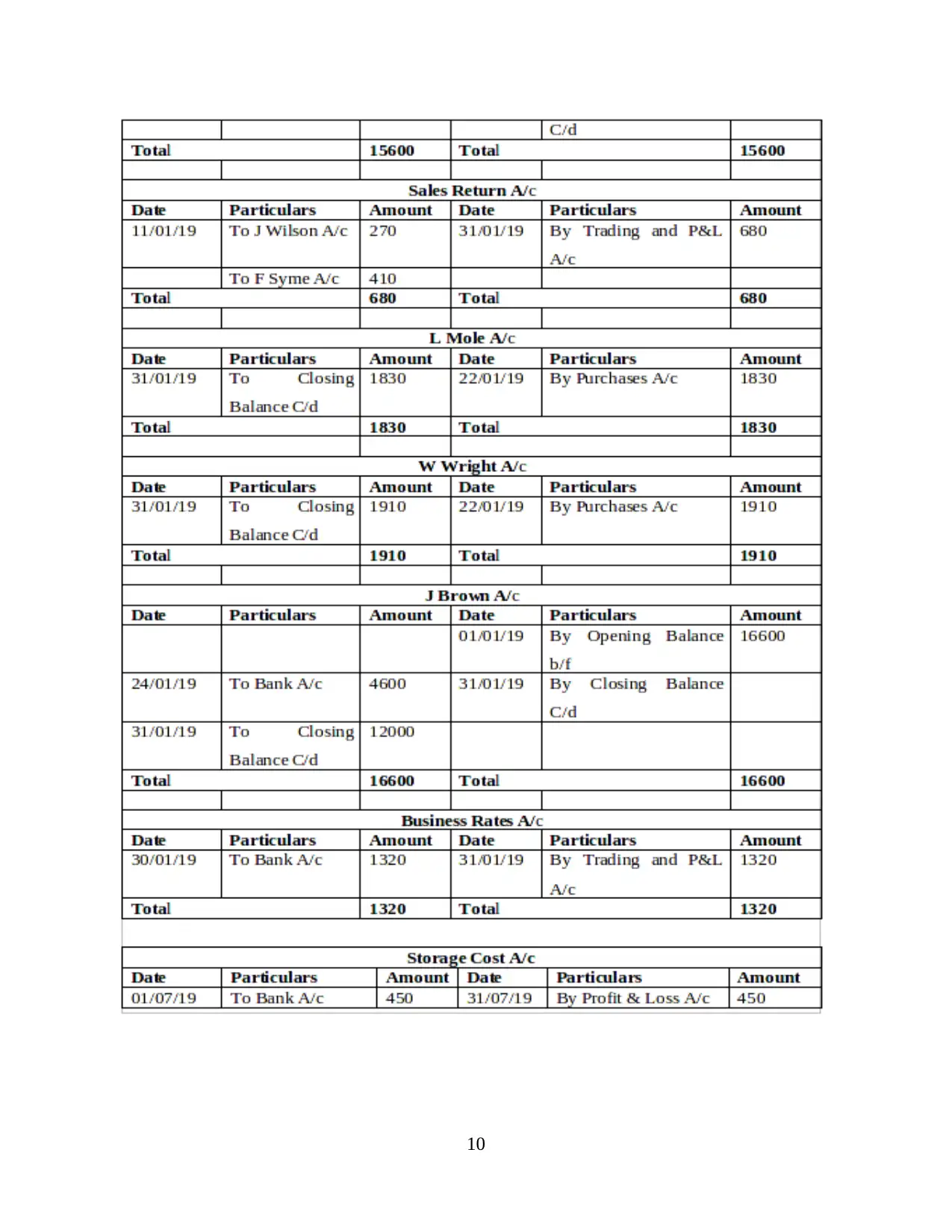
10
⊘ This is a preview!⊘
Do you want full access?
Subscribe today to unlock all pages.

Trusted by 1+ million students worldwide
1 out of 24
Related Documents
Your All-in-One AI-Powered Toolkit for Academic Success.
+13062052269
info@desklib.com
Available 24*7 on WhatsApp / Email
![[object Object]](/_next/static/media/star-bottom.7253800d.svg)
Unlock your academic potential
Copyright © 2020–2025 A2Z Services. All Rights Reserved. Developed and managed by ZUCOL.





